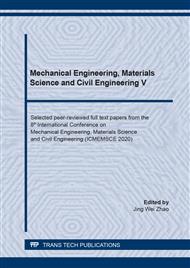p.8
p.13
p.18
p.24
p.31
p.40
p.49
p.56
p.61
Numerical Analysis of Stray Grain Formation during Laser Welding Nickel-Based Single-Crystal Superalloy Part II: Multicomponent Dendrite Growth
Abstract:
Multicomponent dendrite growth is theoretically predicted to optimize solidification cracking susceptibility during ternary Ni-Cr-Al nickel-based single-crystal superalloy weld pool solidification. The distribution of dendrite trunk spacing along the weld pool solidification interface is clearly symmetrical about the weld pool centerline in beneficial (001)/[100] welding configuration. The distribution of dendrite trunk spacing along the weld pool solidification interface is crystallography-dependent asymmetrical from bottom to top surface of the weld pool in detrimental (001)/[110] welding configuration. The smaller heat input is used, the finer dendrite trunk spacing is kinetically promoted by less solute enrichment and narrower constitutional undercooling ahead of solid/liquid interface with mitigation of metallurgical contributing factors for solidification cracking and vice versa. Vulnerable [100] dendrite growth region is predominantly suppressed and epitaxial [001] dendrite growth region is favored to spontaneously facilitate single-crystal columnar dendrite growth and reduce microstructure anomalies with further reduction of heat input. Optimum low heat input (both lower laser power and higher welding speed) with (001)/[100] welding configuration is the most favorable one to avoid nucleation and growth of stray grain formation, minimize both dendrite trunk spacing and solidification cracking susceptibility potential, improve resistance to solidification cracking, and ameliorate weldability and weld integrity through microstructure modification instead of inappropriate high heat input (both higher laser power and slower welding speed) with (001)/[110] welding configuration. The dendrite trunk spacing in the [100] dendrite growth region on the right side of the weld pool is considerably coarser and grows faster than that within the [010] dendrite growth region of the left side in the (001)/[110] welding configuration to deteriorate weldability, although the welding conditions are the same on the either side. Furthermore, the alternative mechanism of crystallography-dependent solidification cracking as consequence of asymmetrical microstructure development and diffusion-controlled dendrite growth of γ phase is therefore proposed. The theoretical predictions are comparable with experiment results. The reliable model is also useful for welding conditions optimization for crack-free laser processing.
Info:
Periodical:
Pages:
31-39
Citation:
Online since:
June 2021
Authors:
Price:
Сopyright:
© 2021 Trans Tech Publications Ltd. All Rights Reserved
Share:
Citation:


